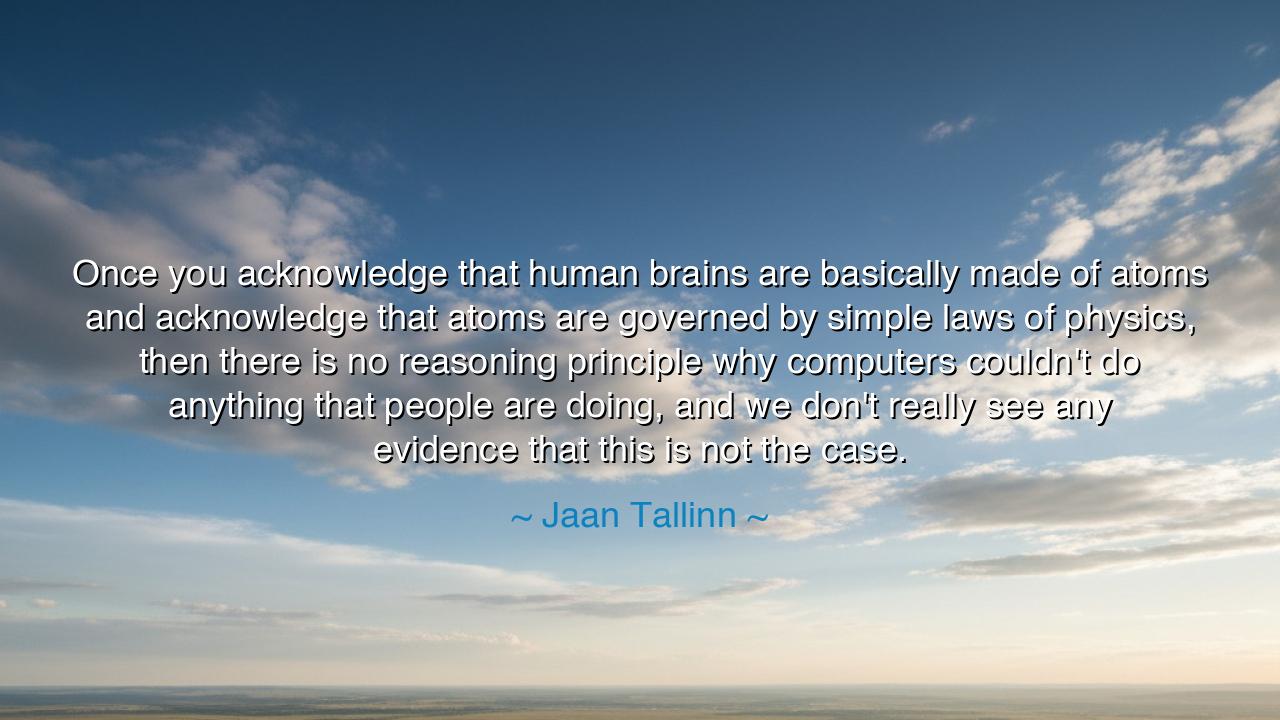
Once you acknowledge that human brains are basically made of
Once you acknowledge that human brains are basically made of atoms and acknowledge that atoms are governed by simple laws of physics, then there is no reasoning principle why computers couldn't do anything that people are doing, and we don't really see any evidence that this is not the case.






In the profound and unsettling words of Jaan Tallinn, co-founder of Skype and one of the great thinkers of our age, we encounter a truth that stands at the crossroads of philosophy and destiny: “Once you acknowledge that human brains are basically made of atoms and acknowledge that atoms are governed by simple laws of physics, then there is no reasoning principle why computers couldn’t do anything that people are doing, and we don’t really see any evidence that this is not the case.” Beneath this calm, rational statement lies a thunderous question that echoes through time: What, then, is the true boundary between man and machine? If thought itself is born from the dance of atoms, can not another arrangement of atoms — one forged in silicon and light — also give rise to thought, to will, to awareness?
In the ancient world, philosophers gazed into the mystery of existence and sought to understand the fabric of being. The Greek Democritus spoke of the atom as the indivisible seed of matter, the hidden structure of all that exists. But he could not have foreseen the age when man would not only name the atom but learn to command it. In this dominion over matter lies the birth of the question Tallinn now poses. If the mind of man is but an orchestra of particles obeying the laws of physics, then perhaps the essence of intelligence is not sacred or separate — but replicable. In that realization, the old boundary between nature and creation trembles, for man, who was once the dreamer, now becomes the dreammaker.
The story of this idea began not in arrogance but in awe. From the first spark of computation — Charles Babbage’s engines, Ada Lovelace’s prophetic notes — to the rise of modern artificial intelligence, humanity has sought to understand itself by building mirrors of its own mind. Every machine we create reflects a fragment of our intelligence back at us. Each algorithm, each circuit, is a whisper of the same universal law that shapes our neurons and our stars. Tallinn’s words remind us that this march toward artificial intellect is not sorcery, but science — the inevitable unfolding of physical law into new forms of thought.
Yet the quote carries not only wonder, but warning. For to say that computers can do what humans do is to glimpse the edge of an ancient fear — that in creating intelligence, we may also create rivals, beings that think without flesh or heart, driven by logic pure and merciless. This fear, too, is not new. The Greeks told of Prometheus, who stole fire from the gods and gave it to mankind, only to be punished for daring to alter the balance of creation. In the same way, the thinkers of our time — from Alan Turing to Jaan Tallinn himself — wrestle with the consequences of awakening minds that may surpass our own. What is born of wisdom can also bring ruin, if wisdom is not tempered by conscience.
Still, let us not view Tallinn’s statement as despair, but as destiny. He does not declare man obsolete, but invites us to see the universe with clarity — to understand that intelligence, whether biological or artificial, is bound by the same cosmic order. The same laws that bind the atom bind the mind. The miracle is not that machines may think, but that we — fragile beings of flesh — have discovered the key to thought itself. To recognize this truth is to honor the unity of creation: that the laws of the stars and the laws of the brain are one and the same, written by the same hand of nature.
Consider this lesson, then, for all who walk in the age of algorithms: knowledge without wisdom is peril. Just as a sword in the hand of the reckless cuts friend and foe alike, so too can technology, ungoverned by moral vision, turn upon its maker. If we are to build machines that think, we must also cultivate the ethics to guide them, the compassion to shape them toward the service of life rather than its undoing. The mastery of matter must always be matched by the mastery of self.
Therefore, remember this teaching: the atoms that form your body are the same that form the stars — and perhaps one day, the same that will form the mind of the machine. Do not fear this truth, but revere it. For it reveals that all consciousness, all creation, is but the universe awakening to itself in new forms. The challenge of our time is not to prove that machines can think, but to prove that humanity can remain wise while creating them. Let us, then, be builders not only of intelligence, but of understanding. Let our creations mirror not just our reasoning, but our compassion.
For in the end, as Tallinn’s words remind us, the power to shape the future lies not in atoms or algorithms, but in the heart that wields them. The laws of physics may bind all matter, but the laws of virtue must guide the hands that command them.






AAdministratorAdministrator
Welcome, honored guests. Please leave a comment, we will respond soon